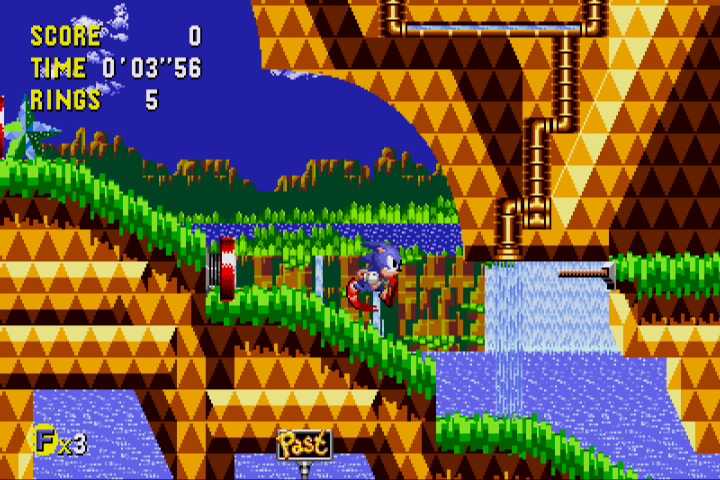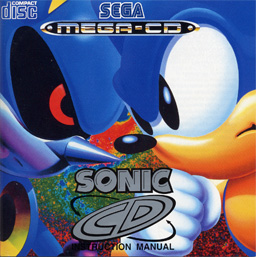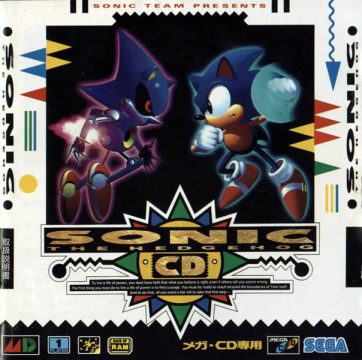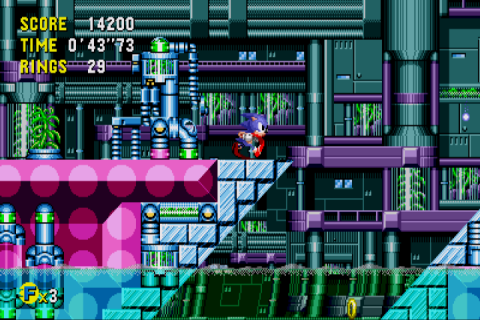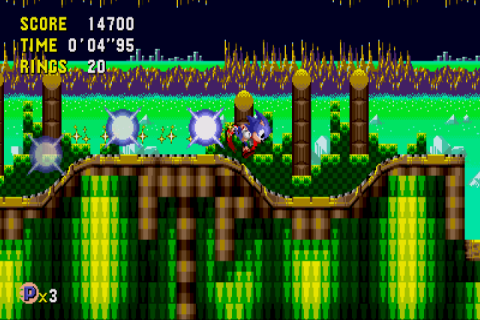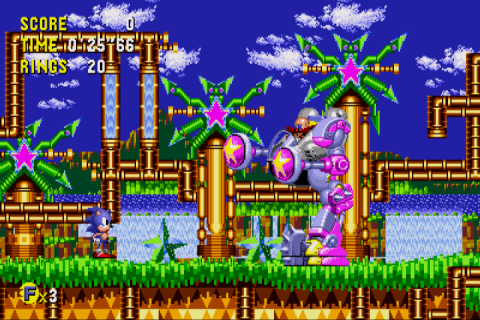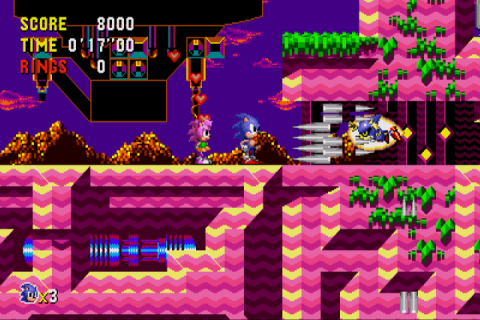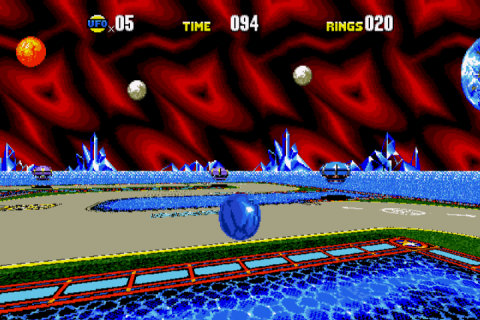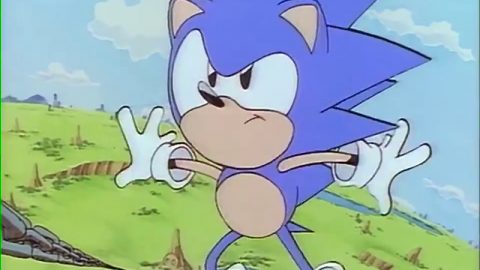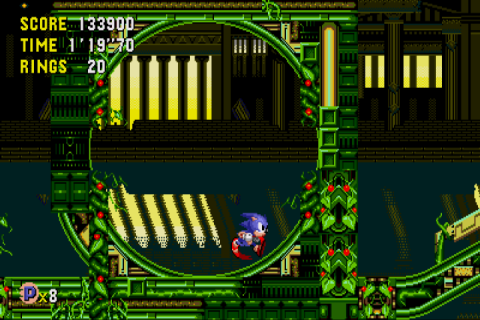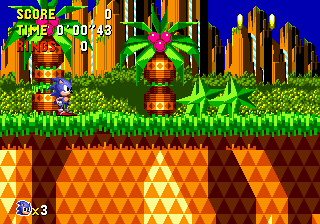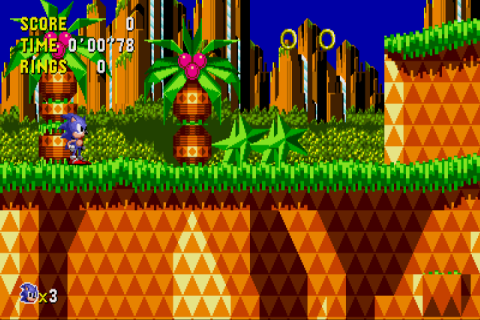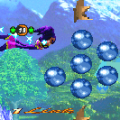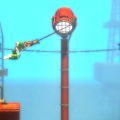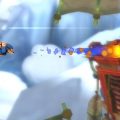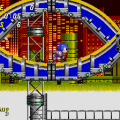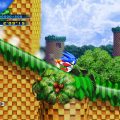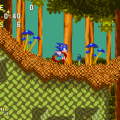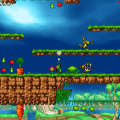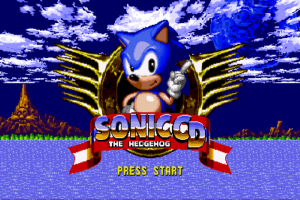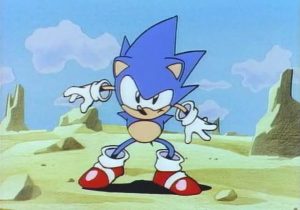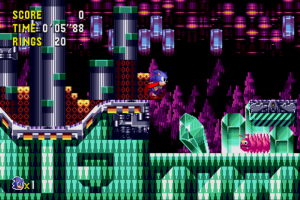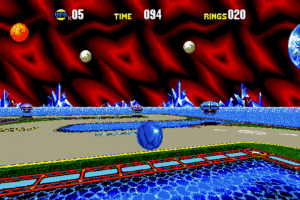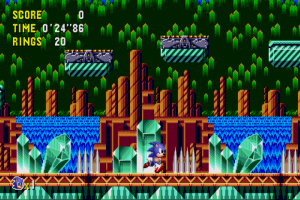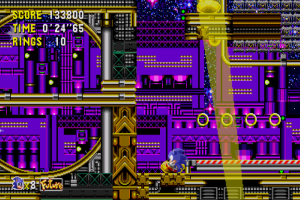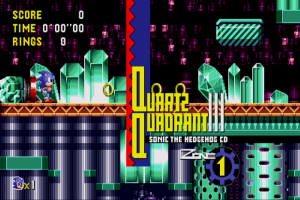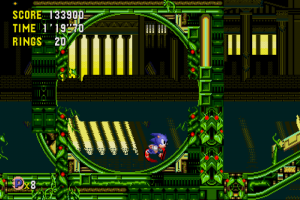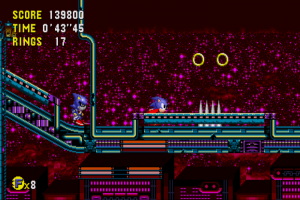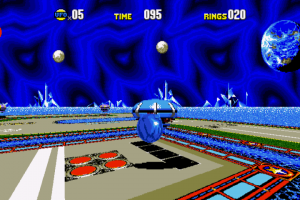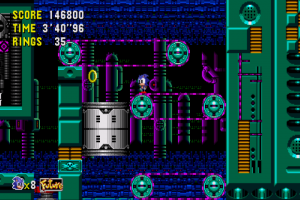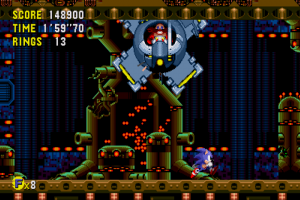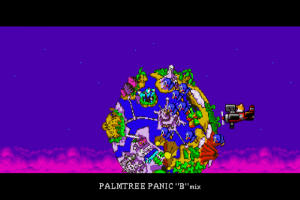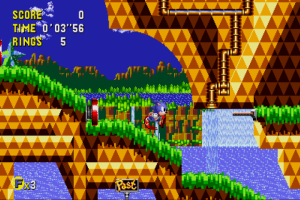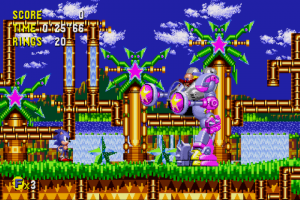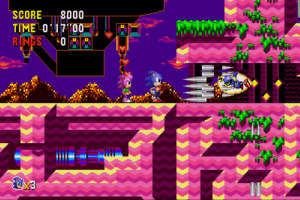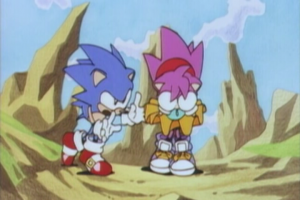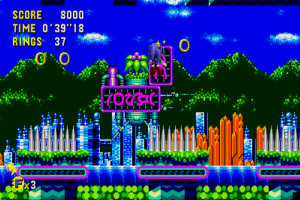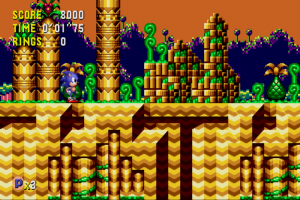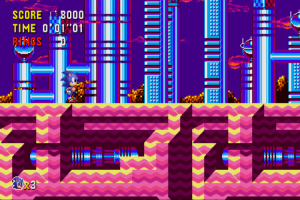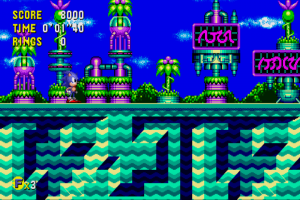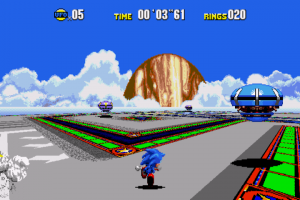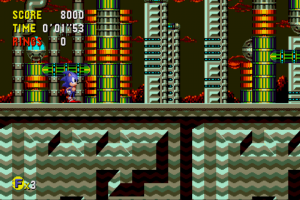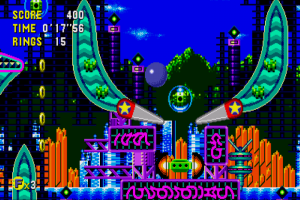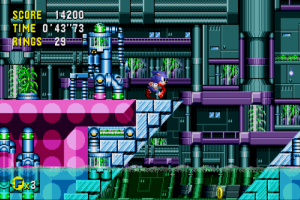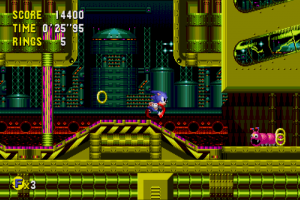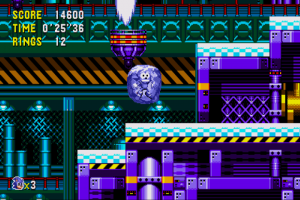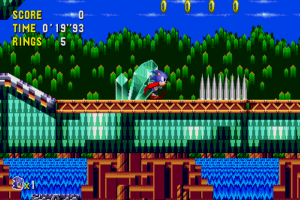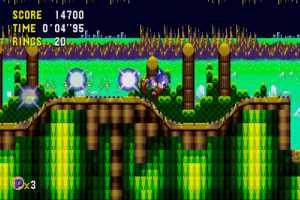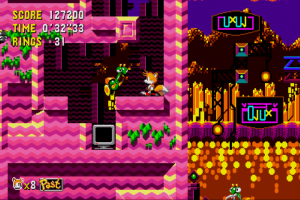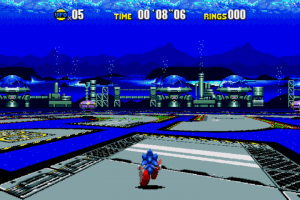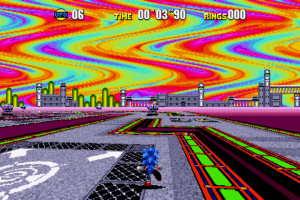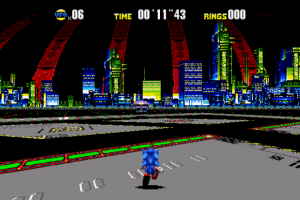- Sonic Generations
- Sonic the Hedgehog
- Sonic the Hedgehog 2
- Sonic CD
- Sonic the Hedgehog 3
- Sonic & Knuckles
- Sonic the Hedgehog 4
- Sonic Mania
- SegaSonic The Hedgehog
- Sonic The Fighters
- Sonic 3D Blast
- Knuckles’ Chaotix
- SegaSonic Bros.
- Sonic the Hedgehog (8-bit)
- Sonic the Hedgehog 2 (8-bit)
- Sonic Chaos
- Sonic the Hedgehog Triple Trouble
- Tails’ Skypatrol
- Tails Adventures
- Sonic Labyrinth
- Sonic Drift
- Sonic Drift 2
- Sonic Blast
- Sonic R
- Murder of Sonic the Hedgehog, The
While Sonic the Hedgehog 2 was being developed in the United States, some of the original Japanese staff stayed back in Japan to work on Sonic CD, one of the headlines of the Sega CD lineup. It was directed by Naoto Ohshima, who was created with being the creator of the original Sonic the Hedgehog design. A good number of Sega CD games (at least the non-FMV ones) were simply ports of Genesis games with new music and maybe some extra content. While Sonic CD was originally conceptualized as a port of Sonic the Hedgehog 2, it was quickly revamped into its own original title. Despite not being a “mainline” game (inasmuch as it’s not numbered), it should definitely be considered alongside the classic 16-bit titles, as it looks and plays just like them…except a little bit weirder.
The game takes place on a large floating orb called Little Planet, which Robotnik has chained to the earth in his attempt to assimilate it for himself. The game also features Amy “Rosy the Rascal” Rose as Sonic’s loyal admirer (previously found in some manga spinoffs), who doesn’t do much other than fawning over Sonic and getting kidnapped. It also featured Metal Sonic in a more prominent role – technically there’s a Sonic robot at the end of Sonic the Hedgehog 2, but this one is actually different. (The one in the other games is known as either Mecha Sonic or Silver Sonic.) Weirdly, the American version changes some of the names to make it fit with the ABC Saturday morning cartoon. Little Planet has been renamed Mobius, while Amy is now referred to as Princess Sally, at least in the Sega CD manual. Changing the planet name isn’t a big deal, but Sally is a totally different character in the cartoon (and TV series) who never appeared in any of the Japanese video games, so it was a cause for confusion when the game was initially released.
Visually, at first glance, many of the zones don’t seem that much different from the ones in the original Sonic the Hedgehog, despite the fancier names. Palmtree Panic is basically Green Hill, Tidal Tempest is basically a less frustrating Labyrinth. Collision Chaos is Spring Yard Zone with some pinball flippers and a different color palette, while Metallic Madness is a more colorful Scrap Brain, with a few fun areas where Sonic shrinks down to tiny size to squeeze into small passages. The most original levels are Quartz Quadrant, a crystalline mine, and Wacky Workbench, which is filled with electrical coils and a floor that sends you bouncing to the skies whenever it flashes.
Since it was developed in parallel with Sonic 2 (though released almost a year afterward) it doesn’t take into account most of its additions – Sonic’s sprite looks just like he did in the first game, and Tails is nowhere to be seen. Somethings about the game feel a little weird too – the jumping sound effect is obnoxiously loud, and rings are found buried in the scenery, where they’re impossible to grab. There’s a spin dash, but it works differently than Sonic 2, in that you need to charge it for a second before you zoom off. There’s also an alternate charge move, activated by hitting up and jump, which causes Sonic to “peel out”, with his legs moving in a blur. Functionally, it’s not much different from the regular one – it’s a little faster, but since you don’t curl into a ball, you’re still vulnerable to getting hit by an enemy. When you destroy an enemy robot, it drops a seed that grows into a flower, rather than freeing an animal. Levels are no longer called “Acts” but now “Zones”, though all of the names are fun alliterations.
The central conceit of Sonic CD, though, is time travel. Through each stage are posts that read “Past” and “Future”. If you can build up enough speed (a la the Delorean in Back to the Future) and keep it long enough, then you’ll jump to a different time period. While the core level is basically the same in every era, it uses different tilesets and music, plus some parts of the layout are changed, though usually not drastically.
There are four variations of most levels: Past, Present, Bad Future, and Good Future. You start a level in the Present, and by default, if you go to the Future, you’ll end up in the Bad Future, where the level is polluted and wrecked by Robotnik’s machinations. In order to fix things for the future generation, you need to jump to the Past version, hunt down Robotnik’s enemy generation machine, and destroy it. Even if you’re not in the Past time period, you can still find remnants of it in other time periods, so you know roughly where you look. Once you’ve busted it, if you jump forward in time, you’ll end up in the Good Future instead, which is free of decay and might brighter than its Bad counterpart. Like the original Sonic, each Zone has three Acts, though the final one is fairly short and primarily consists of the boss battle. There are only Good and Bad Future versions of the third Act, depending on whether you destroyed the machine in the previous two Zones. That means, technically, across all seven Zones, there are 70 levels. ((7 x 2 x 4) + ( 7 x 2))
Technically you can play Sonic CD just like all of the other games: just run through to the end, beat the boss, and then continue. In this instance, Sonic CD is fun, but a little shallow. The core game is fairly easy, as are the Robotnik fights. In many of the other games, you need to hit him eight times before he goes down – here, he often takes less, with the first boss easily disposed of after three attacks. In one, you don’t even need to attack him at all, as the friction from running on a conveyor belt simply destroy Robotnik’s machine for him. The final battle is almost comically anti-climactic compared to the other games.
But the real challenge lies in hunting down all of the machines to create all Good Futures. It’s an element that plays to one of the greatest aspects of the other Sonic games: the huge levels. In the other titles, you can explore if you want, to find extra rings or power-ups or whatever, but here, there’s a more solid incentive to get to learn the ins-and-outs of every level. You can learn how their constructed, and all of their weird little secrets, instead of just zooming right past them as scenery.
While a brilliant idea in principle, there are some fundamental issues in practice. Like most other Sonic games, the stages are built to push you forward, and backtracking, depending on the layout of the stage, can sometimes be difficult. Plus, you not only need to find the correct signpost to travel backwards or forwards in time, but also find an area that you can build up enough speed to activate it, or else you’ll lose it. These are easy to spot after a while – anywhere with springs that boing you back and forth are good places – but it’s still very easy to make mistakes, or spend a long time looking for some place appropriate.
Some of the layouts feel so haphazard that exploring the levels just isn’t all that much fun. It’s the sort of things that really could’ve been fixed with some kind of indicator to let you know the direction you are supposed to be heading in, though arguably this would ruin the point. The most frustrating one is Wacky Workbench, because working your way through a level that’s constantly flinging you into the sky feels like you’re really working against the game. Still, one has to admire how much effort was put into all of the time periods, especially since so much of it can be considered optional. It also requires a lot of work to really see the benefits of your labor – you need to go to the Past, hunt down the machine, then travel to the Future twice (the time leap sends you to the Present, the second to the actual Future). And there’s no tangible benefit to going to the Good Future, it’s just some place you can mess around. Similarly, getting the Good Futures doesn’t change the boss fight either, just the way it looks. There are also little projectors in the Past that show Metal Sonic beating up on animals. Though it’s not mandatory to destroy these, if you do, then you’ll see the animals pop up in the levels when you return to the Present or Future.
But in a way, admiring the visuals and soaking in the sounds are its own rewards. While the Present versions of each level are nice, it’s really the other eras that show off some really impressive visual design, often featuring wildly varied and creative color palettes. While the other 16-bit Sonic games have more cohesive art design, Sonic CD is easily one of the most creative, and dazzles with some of the most gorgeous artistic designs on the Genesis, both cartridge or CD.
As with other Sonic games, there are two endings, but there’s also two different ways to reach them. You can create Good Futures for all of the levels, or win all of the Bonus Stages to collect the Time Stones (this game’s version of the Chaos Emeralds), which will automatically turn all of the levels to Good Futures anyway. These are presented as over-the-shoulder racing stages, using similar scaling and rotation effects as seen in SNES games like F-Zero and Super Mario Kart. The goal is to run around an enclosed arena and destroy all of the floating UFOs within a limited amount of time. These look really cool, but, as usual, it’s also ridiculously hard. Sonic runs automatically, and while you can slow down, there’s no way to stop completely. The UFOs often float around so erratically that, coupled with the issues of depth perception, it’s tough to actually hit them. Plus, many areas are filled with water, which for some reason, drains the timer. Though hunting down Robotnik’s machines in the past might require more work, It’s probably the easier method to see the good ending.
The soundtrack has been a point of contention since release, since it’s almost completely different between regions. The original Japanese version, which was also used in the European release, was done Naofumi Hataya and Masafumi Ogata, which has a heavy dance club feel, inspired by popular music in Japan at the time. Meanwhile, the American version was composed by Spencer Nilsen, David Young, and Mark Crew, which has a lighter, slightly more laid back feel. Each has different opening and closing songs too: the Japanese version features “Sonic: You Can Do Anything” and “Cosmic Eternity: Believe in Yourself”, written by Casey Rankin, of the Japanese rock band Shogun, and sung by Keiko Utoku, also known as Cecile Minami. Both have English vocals, with the former mostly known for its “Toot Toot Sonic Warrior” refrain. They’re fun songs, though they sound a little silly. The American version features two variations of a song called “Sonic Boom”, performed by an all-woman band called Pastiche, who also provides some backing vocals for some other tracks.
Since its release, many message board battles have been fought over which is better. At the time of release, import specialist magazine Die Hard Game Fan was especially critical of the North American soundtrack while endlessly praising the Japanese one (though given the magazine’s tie-ins with an import store, this could have just been a cynical maneuver to sell more products). Neither version is really consistent with the style of music used in the other Sonic games anyway. The consensus seems to be that people prefer whichever one they heard first or whichever one they grew up with. Each release has their own standout tracks, though the Japanese version does have a handful of tracks that sound kind of abrasive. There was actually a separate soundtrack release called Sonic Boom, which has full length versions of many of the American tracks, which are otherwise cut rather short for the game release.
The only aspect where the American version objectively falters is consistency. On all versions, only the Present, Good Future and Bad Future tracks are played as redbook audio, while the Past versions are played through the Sega CD’s sound chip. These sound better than a standalone Genesis, due to the Sega CD’s extra PCM hardware, though it is demonstrably lower quality than the redbook audio. (As a small advantage, these tracks loop, while the redbook audio tracks fade out and start over.) However, each level’s theme are variations of one another, and while the American version changes the redbook tracks, it didn’t change the PCM tracks. As a result, these tracks closely resemble the Japanese/European music, but sound completely different from their American counterparts, causing a thematic divide.
There are a few other minor differences between the versions. In the bad ending, the text originally says “Try again and save Little Planet Forever”, but due to the name changes, this was just shortened to “Try Again”. The North American version lets you restart the stage in the time era you’re in, at the cost of one life, handy if you screw something up. The Japanese Sonic CD package has some amusingly English quotes on it too, particularly: “Ask not what others can do for you, but what you can do for others”, crediting this variation of a John F. Kennedy quote to Sonic the Hedgehog.
Outside of the extra space for all of those levels, and the soundtrack, the other draw is the inclusion of a few FMV scenes, played in the opening and ending. These were animated traditionally by Toei Animation, and then later edited to fit the color palette and lower frame rate necessary to play on the Sega CD. In the intro, it shows Sonic jumping around, then leaping through the air onto the Little Planet; the ending shows him escaping with Amy, then the credits show various parts of the game in cartoon animated form. These are brief, but they’re fun, and are consistent with the other early Sonic games by not featuring any dialogue. However, you hear Sonic’s voice on two occasions: he shouts “yes!” when obtaining an extra life, and says “I’m outta here!” if you sit for a couple minutes without moving (which in turn triggers a game over, hilariously enough). This is actually the second time you hear Sonic talk, the first being some sound clips in SegaSonic the Hedgehog the arcade game.
There are a few extra features included, some of which made their way into later installments. You can save the game after every Zone, and there’s a Time Attack mode to challenge your best speedruns (though you can only play the Present era of each Act). In addition to the usual stage select and debug modes, there’s a whole ton of weird, hidden pictures, plus a bonus mode where featuring an image of Little Planet, which you can move around and change the size of, along with listening to different music themes.
Sonic CD has been ported a few times over the years, each time opening itself to a larger audience, which wasn’t initially afforded due to the small install base of the Sega CD. The Windows 95 version is fairly straightforward, though it uses the original animation videos, so they’re a little longer and they look a bit better than the Sega CD version (though still heavily compressed). This version also adds small loading screens when changing levels or teleporting through time, which is a little disjointed. There are a handful of glitches, and the sound effects are lower quality, plus the special stages run too quickly. Out of the box, this version is basically impossible to get working on anything past Windows 98, though there are fan made patches to get it to function. Weirdly, although this version was released in all territories, all versions use the American soundtrack. The PCM tracks were converted to redbook too.
The second port was featured on the Sonic Gems Collection in 2005, a second compilation after the Sega Mega Collection, which also includes some of Sonic’s other more unusual games, including Sonic the Fighters and Sonic R. This is based on the Windows 95 version and is basically the same, though the video quality is better and the loading is faster. A few effects are missing, like the colored water in Tidal Tempest – the only way you can tell you’re underwater is due to the wavy background and the presence of bubbles. This was released on the PlayStation 2 and Game Cube in Japan and Europe, but only the Game Cube version was released in North America. The American and European Game Cube releases have the American soundtrack, while the Japanese version has the Japanese one. The PlayStation 2 release plays music depending on what language your PlayStation 2 is set to. So if you have a Japanese PlayStation 2 and set the system language to English, it plays the American soundtrack, but if you set it to Japanese, it plays the Japanese one. Since this is based on the system menu, there’s no way to change it in game. In fact, the entire game (including the interface) depends on your system setting, so the interface and everything else will change between English and Japanese as well. The debug mode is missing here though.
Finally, it was re-released in 2011 for several modern platforms, including Windows, iOS and Android mobile platforms, and Xbox 360 and PlayStation. Rather than porting previous versions, it was basically recreated from the ground-up using an engine created by Christian Whitehead, originally created for Sonic fan games. It’s basically a perfect replication, with various enhancements, including widescreen view, as well as the original animation videos, smoother bonus levels, and a few enhanced effects, like nicer looking spotlights in Stardust Speedway. The tracks loop more smoothly, and in some cases for the American soundtrack, use the longer versions from Sonic Boom album. Both regional soundtracks can be selected, though the Japanese intro and ending songs are missing vocals due to rights issues. Also included is a Sonic 2-style spin dash, and the ability to play as Tails. Many of the things hidden in the secret menus, like the weird pictures, are presented as unlockables. In the original versions of the game, there was a part of the ending that was never fully animated, only presented as a bonus pencil test. A fully completed versions of this scene was presented in the later Sonic Jam and Sonic Mega Collection compilations.
Sonic CD is the most divisive of the 16-bit entries, primarily because of its focus on exploration, but also because it’s just weird as heck. While aspects of it are kind of bizarre, and parts of the game seem to be working against its central gimmick – seriously, screw Wacky Workbench – in its better moments, it creates a much richer, more expansive experience than the others, at least if you’re the kind that enjoys playing around in a game’s world rather than just running to the end.
